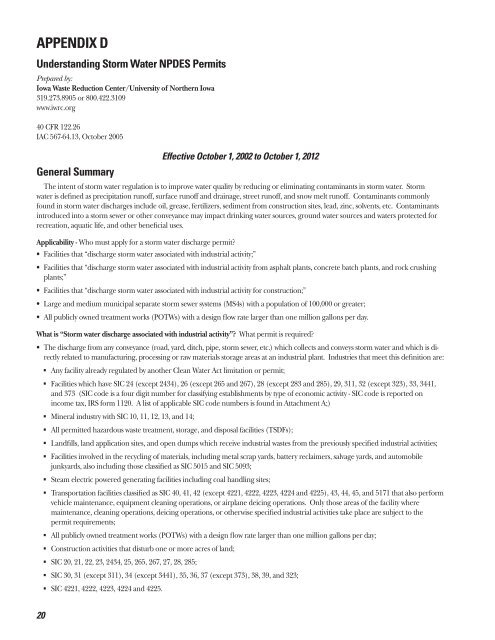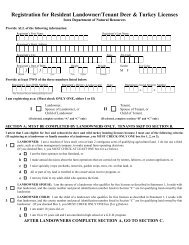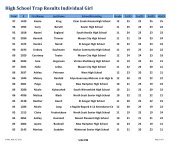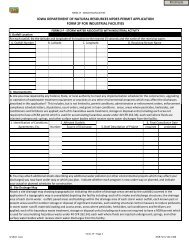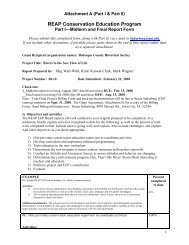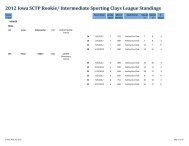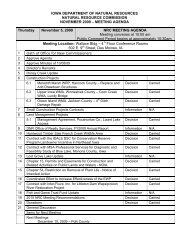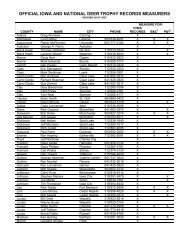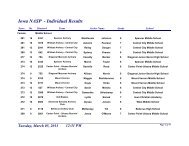Waste Reduction, Construction and Demolition Debris - Iowa ...
Waste Reduction, Construction and Demolition Debris - Iowa ...
Waste Reduction, Construction and Demolition Debris - Iowa ...
You also want an ePaper? Increase the reach of your titles
YUMPU automatically turns print PDFs into web optimized ePapers that Google loves.
APPENDIX D<br />
Underst<strong>and</strong>ing Storm Water NPDES Permits<br />
Prepared by:<br />
<strong>Iowa</strong> <strong>Waste</strong> <strong>Reduction</strong> Center/University of Northern <strong>Iowa</strong><br />
319.273.8905 or 800.422.3109<br />
www.iwrc.org<br />
40 CFR 122.26<br />
IAC 567-64.13, October 2005<br />
General Summary<br />
Effective October 1, 2002 to October 1, 2012<br />
The intent of storm water regulation is to improve water quality by reducing or eliminating contaminants in storm water. Storm<br />
water is defined as precipitation runoff, surface runoff <strong>and</strong> drainage, street runoff, <strong>and</strong> snow melt runoff. Contaminants commonly<br />
found in storm water discharges include oil, grease, fertilizers, sediment from construction sites, lead, zinc, solvents, etc. Contaminants<br />
introduced into a storm sewer or other conveyance may impact drinking water sources, ground water sources <strong>and</strong> waters protected for<br />
recreation, aquatic life, <strong>and</strong> other beneficial uses.<br />
Applicability - Who must apply for a storm water discharge permit?<br />
• Facilities that “discharge storm water associated with industrial activity;”<br />
• Facilities that “discharge storm water associated with industrial activity from asphalt plants, concrete batch plants, <strong>and</strong> rock crushing<br />
plants;”<br />
• Facilities that “discharge storm water associated with industrial activity for construction;”<br />
• Large <strong>and</strong> medium municipal separate storm sewer systems (MS4s) with a population of 100,000 or greater;<br />
• All publicly owned treatment works (POTWs) with a design flow rate larger than one million gallons per day.<br />
What is “Storm water discharge associated with industrial activity”? What permit is required?<br />
• The discharge from any conveyance (road, yard, ditch, pipe, storm sewer, etc.) which collects <strong>and</strong> conveys storm water <strong>and</strong> which is directly<br />
related to manufacturing, processing or raw materials storage areas at an industrial plant. Industries that meet this definition are:<br />
■<br />
Any facility already regulated by another Clean Water Act limitation or permit;<br />
■<br />
Facilities which have SIC 24 (except 2434), 26 (except 265 <strong>and</strong> 267), 28 (except 283 <strong>and</strong> 285), 29, 311, 32 (except 323), 33, 3441,<br />
<strong>and</strong> 373 (SIC code is a four digit number for classifying establishments by type of economic activity - SIC code is reported on<br />
income tax, IRS form 1120. A list of applicable SIC code numbers is found in Attachment A;)<br />
■<br />
Mineral industry with SIC 10, 11, 12, 13, <strong>and</strong> 14;<br />
■<br />
All permitted hazardous waste treatment, storage, <strong>and</strong> disposal facilities (TSDFs);<br />
■<br />
L<strong>and</strong>fills, l<strong>and</strong> application sites, <strong>and</strong> open dumps which receive industrial wastes from the previously specified industrial activities;<br />
■<br />
Facilities involved in the recycling of materials, including metal scrap yards, battery reclaimers, salvage yards, <strong>and</strong> automobile<br />
junkyards, also including those classified as SIC 5015 <strong>and</strong> SIC 5093;<br />
■<br />
Steam electric powered generating facilities including coal h<strong>and</strong>ling sites;<br />
■<br />
Transportation facilities classified as SIC 40, 41, 42 (except 4221, 4222, 4223, 4224 <strong>and</strong> 4225), 43, 44, 45, <strong>and</strong> 5171 that also perform<br />
vehicle maintenance, equipment cleaning operations, or airplane deicing operations. Only those areas of the facility where<br />
maintenance, cleaning operations, deicing operations, or otherwise specified industrial activities take place are subject to the<br />
permit requirements;<br />
■<br />
All publicly owned treatment works (POTWs) with a design flow rate larger than one million gallons per day;<br />
■<br />
<strong>Construction</strong> activities that disturb one or more acres of l<strong>and</strong>;<br />
■<br />
SIC 20, 21, 22, 23, 2434, 25, 265, 267, 27, 28, 285;<br />
■<br />
SIC 30, 31 (except 311), 34 (except 3441), 35, 36, 37 (except 373), 38, 39, <strong>and</strong> 323;<br />
■<br />
SIC 4221, 4222, 4223, 4224 <strong>and</strong> 4225.<br />
20


